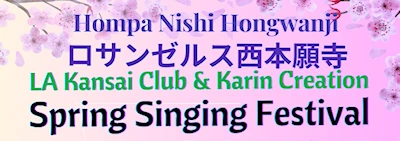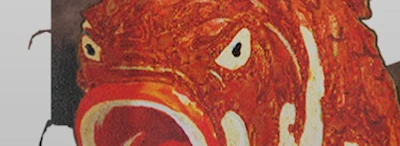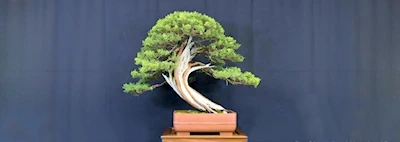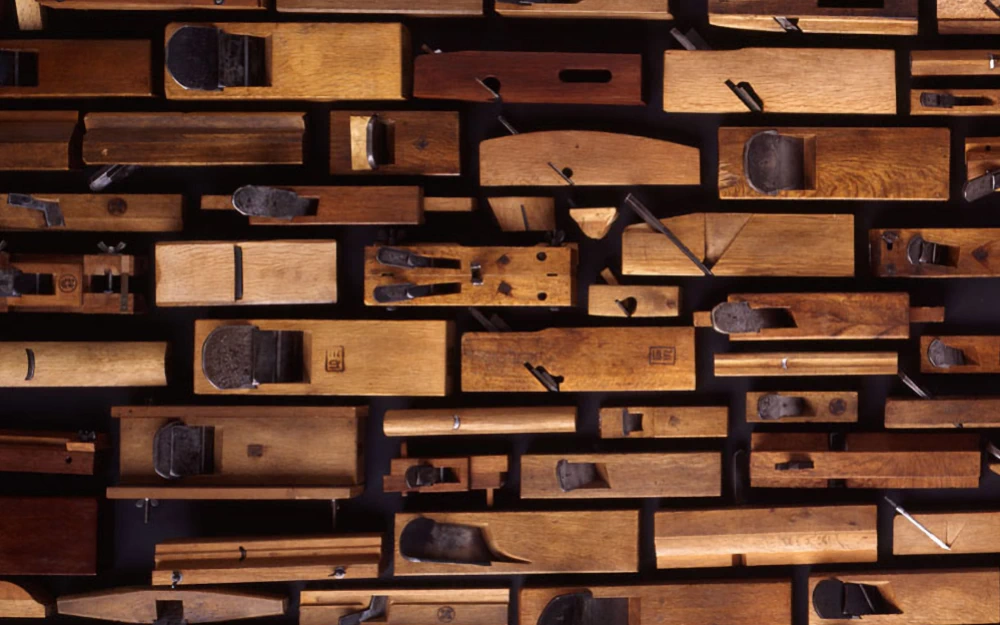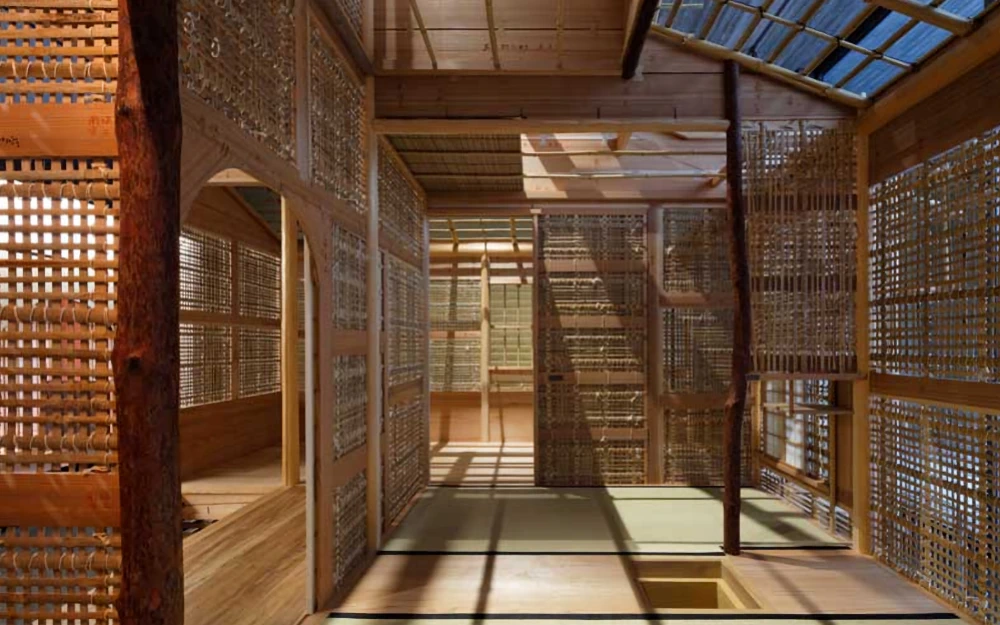2024 Masters of Carpentry: Melding Forest, Skill and SpiritNEW
-
May 20, 2025, Tuesday (52 Days): 11:00 am
2025 Complimentary Green Tea Service, Japan House (Enjoy a Free Drink & Wi-Fi, Browse Books, & Take in Stunning Views of Los Angeles) Other Events At This Location
Japan House, Los Angeles
This Specific Event Date Has Passed
Upcoming Events and Dates at This Location
Second & Fifth Floors
Los Angeles, CA 90028
The exhibition “Masters of Carpentry: Melding Forest, Skill and Spirit” welcomes visitors into the world of the Japanese daiku, or master carpenters - the guardians of the timeless traditions and cultural heritage of Japan’s wood craft.
In Japan, a rich tradition of carpentry and wood craftsmanship has flourished over centuries, nurtured by imperial and sacred architecture, and propelled by the nation's economic and cultural development. Daiku, the revered masters of Japanese carpentry and woodcutting, have long honored nature, seeking the benevolence of mountain deities in gathering their materials. Central to their ethos is the imperative of sourcing wood in harmony with the forest, advocating for the meticulous selection of materials tailored to each application. Japanese woodworking practice, renowned for its precision, is thus rooted in a profound reverence for nature and environmental balance.
Despite the challenges of mountainous forest terrain and limited natural metal ore resources, Japanese master carpenters have displayed remarkable innovation, pioneering world-class carpentry tools and kigumi, wood joinery techniques characterized by their simplicity and efficiency. This exhibition pays homage to the Japanese carpenters - builders of temples, shrines, and teahouses - showcasing their tools and their indispensable joinery, from the delicate to the robust, inherent in this important cultural architecture.
This JAPAN HOUSE touring exhibition is produced in conjunction with the Takenaka Carpentry Tools Museum in Kobe, Japan, and a symbol of the museum's longevity and commitment to preserving the Japanese daiku culture. Marking its 40th Anniversary in 2024, the museum has continued to collect carpenters’ tools and reintroduce daiku culture which has been in danger of disappearing since the second half of the 20th century. The exhibition will debut at JAPAN HOUSE Los Angeles before traveling to JAPAN HOUSE locations in London and São Paulo.
Exhibition Dates
Nov 20, 2024 - Jan 22, 2025
Explore the Exhibition
The exhibition is structured around 5 pillars of daiku culture:
1) The master carpenters’ refined tools
2) A reverence for nature and the Japanese forest
3) The practice of dōmiya daiku - the shrine and temple carpenters
4) Kigumi - the strength and beauty of Japanese joinery
5) The work of the sukiya daiku - the skillful carpenters employing natural materials to detail and finish elegant teahouses
A re-created section of the hipped roof from the Tōindō (Eastern Hall) of the Yakushiji Temple in Nara and a full-scale model of the Sa-an Teahouse (seen in the image above) at Daitoku-ji Temple in Kyoto, exemplify the continuing holistic relationship between forest, skill, and spirit deeply ingrained in the Japanese daiku tradition.
The Tools
In Japan, it is said that tools reflect one’s capability and the potential of their work. A quote from master carpenter Tsunekazu Nishioka embodies this notion: "When you study someone's tools, you come to know their skill. By observing how they handle their most important possessions, their tools, you come to understand their attitude toward their work." The exhibition opens with a diverse array of tools including planes, chisels, and saws. These objects - stunning in their own right - convey the spirit of preparation that leads to excellence in craft and ultimately the beautiful architecture which has stood the test of time.
Nature and Forest
The primary characteristic of Japanese woodworking technology is often said to be its intrinsic precision. However, behind this is the craftsman's skill and spirit nurtured by the Japanese people's unique reverence for nature and the environment. Today, when we must reconsider the global environment for all humanity, we can find wisdom in the holistic relationship the daiku have with the forest and in their traditions that transcend history. As visitors enter deeper into the exhibition space, they are greeted with the sounds and subtle aromas of the Japanese forest. Scents of cedar and cypress mingle in an enchanting immersive presentation of Japan’s indigenous timber and the ritual garments, tools, and implements of the daiku tree felling ceremonies.
Emerging from the forest experience, the main gallery opens to an expansive display of kigumi, or wood joinery. The kigumi models are presented reflecting the techniques used within the realms of the shrine and temple builders, the dōmiya daiku, and the artisans of teahouse construction, the sukiya daiku.
Dōmiya Daiku
Crafted wooden models reveal the structures hidden within the ancient buttresses and sweeping rooflines of Japan’s temples and shrines, which absorb the shock from earthquakes and can be replaced or repaired by future generations ensuring these monumental wooden buildings endure for centuries.
Kigumi
The kigumi (joinery) models feature the techniques known as tsugite and shiguchi. Tsugite refers to the method of joining components end-to-end in the same direction lengthening material (a scarf joint), while shiguchi refers to methods of joining components at right or various angles (dovetail, rabbet, mortise and tenon joints, for example). Examples of the detailed processes of sashimono and kumiko, the intricate woodwork used in furniture and interior architectural fittings, impart the impressive sophistication of the more refined aspects of kigumi. Specific “hands-on” presentations will be available for guests to directly experience the strength and stability of larger structural kigumi designs and the delicate finesse of finer finishing joints.
Sukiya Daiku
The exhibition culminates in a glimpse into the sukiya architecture of the teahouse, highlighting the artistry of these simple structures, which value delicacy and transience over robustness. The full-size model of the Sa-an style of Japanese teahouse encapsulates the sukiya process which accentuates the organic shape, texture, and color of timber, bamboo, clay and grass. Three guest master carpenters from Japan realized the structure over five days, leaving it elegantly unfinished to reveal the inner walls and frame.
Through this exhibition the natural beauty of this vital cultural heritage is elevated, serving as a testament to the enduring legacy of craftsmanship and the unique melding of forest, skill and spirit within Japan’s Masters of Carpentry.
About the Curator: Marcelo Nishiyama
Marcelo Nishiyama is a curator specializing in architectural history and design at The Takenaka Carpentry Tools Museum (TCTM). He has curated an array of exhibitions based on research in the field of building technology. His work covers a wide range of subjects, including carpentry and tools, blade making and the art of sakan (Japanese plasterwork), as well as the latest building techniques such as Cross-laminated timber (CLT). He has recently curated exhibitions on behalf of TCTM at the Manggha Museum (Poland) and the Maison de la Culture du Japon à Paris (France).
Disclaimer: Please double check all information provided on our platform with the official website for complete accuracy and up-to-date details.
Wednesday, 18 December, 2024
Event Contact
Masters of Carpentry, Masters of CarpentryEvent Organizer Website
Visit Organizer Website
Get More Details From the Event Organizer
Event Location Website
Visit Location Website
For More Location Details
Event Information Can Change
Always verify event information for possible changes or mistakes.Contact Us for Issues





